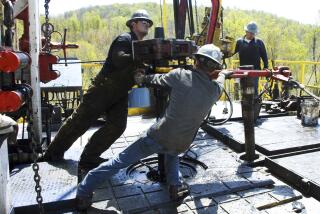Arctic Drilling Is No Energy Answer
- Share via
The Senate’s tentative approval of oil drilling in the Arctic National Wildlife Refuge has again focused attention on the nation’s most pressing energy concern: growing U.S. dependence on imported oil. As recently as 1986, the United States relied on foreign oil for less than one-third of its total supply; now we are 56% reliant on imports. With rising dependency, we have become more vulnerable to supply disruptions and entanglement in foreign oil wars, dangers plainly evident in the Middle East today.
President Bush and his allies in the Senate claim that drilling in ANWR for U.S. oil will diminish these risks, but close examination of the problem suggests that ANWR cannot reduce U.S. dependency on imports to any significant degree. More important, by spotlighting ANWR’s putative advantages, the administration obscures the fact that its overall energy policy actually increases U.S. oil dependency.
According to the most optimistic estimates, ANWR holds 10 billion barrels of oil. It is unclear, however, how much of it can be extracted at reasonable cost and without causing excessive environmental damage. At best, ANWR would pump out only about 1 million barrels per day in 2015, when all of the necessary pipelines are in place. That may seem a lot, but in fact it represents only 4% of anticipated U.S. petroleum consumption and 6% of all imports.
If long-term U.S. dependence on foreign oil was trending downward, an additional 6% reduction might make a dent in our reliance on foreign oil. But the opposite is true: According to the latest Department of Energy projections, U.S. reliance on imported petroleum will rise from 58% in 2010 to 65% in 2020 and 68% in 2025, and keep climbing after that. If the projections are accurate, the tiny fraction of U.S. imports potentially accounted for by ANWR would only grow smaller with each passing year.
The projected increases also mean that the U.S. is at ever- increasing risk of harm from disruptions in the global flow of petroleum. U.S. foreign policy and, no doubt, our troops must continue to be deployed in service of foreign oil potentates, such as the monarchs of Saudi Arabia, and contain those who pose a threat to our energy supplies, such as the mullahs of Iran.
It follows that the question we need to ask is not, “Should we drill in ANWR?” but, “What, besides drilling in ANWR, is the Bush administration doing to reduce our reliance on imported petroleum?” The answer, unfortunately, is virtually nothing.
True, the president has called for accelerated research on more fuel-efficient vehicles, including hydrogen-powered fuel-cell automobiles. But at the current meager level of research spending, it will be decades -- if ever -- before affordable fuel-cell vehicles will be available. And beyond this, all of the oil-related recommendations contained in the administration’s May 2001 National Energy Policy (a.k.a. the Cheney report) are devoted to obtaining energy in ways that would increase rather than decrease U.S. reliance on imported petroleum.
In particular, the Cheney report identified two priorities: first, to expand the role of U.S. energy firms with Middle East producers, so as to boost those producers’ net output, and, second, to increase U.S. imports from other areas of the world.
In line with the first objective, the report called for the U.S. to persuade the leaders of Saudi Arabia, Kuwait and other Persian Gulf producers “to open up areas of their [state-owned] energy sectors to foreign investment.” In support of the second, it affirmed that “we need to strengthen our trade alliances, to deepen our dialogue with major oil producers, and to work for greater oil production in the Western Hemisphere, Africa, the Caspian and other regions with abundant oil reserves.”
This is not a program of energy independence, as claimed by the president. Rather, it is a blueprint for permanent bondage to energy producers of the developing world. Seen from this perspective, ANWR is a sideshow -- a minor distraction from the main story of growing U.S. dependence on imports.
American leaders must vote their consciences when the question of drilling in ANWR comes up for a final vote. They must decide whether the refuge’s puny contribution to diminished U.S. dependency really outweighs the inevitable environmental damage that will accompany turning a wilderness area from pristine to developed, however carefully it is done. And those who vote yes can’t tell us that it will mark a major step toward U.S. energy independence; if they do, they are fooling themselves.
Until this country adopts a serious program of energy conservation and transformation, including tough automotive fuel-efficiency standards and the development of alternative sources of fuel, we will remain deeply dependent on foreign oil -- ANWR or no ANWR.
More to Read
Inside the business of entertainment
The Wide Shot brings you news, analysis and insights on everything from streaming wars to production — and what it all means for the future.
You may occasionally receive promotional content from the Los Angeles Times.










